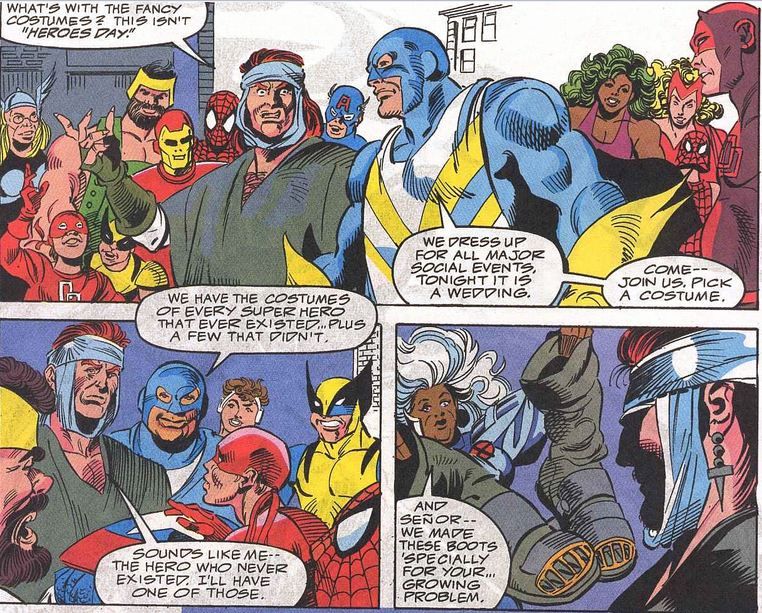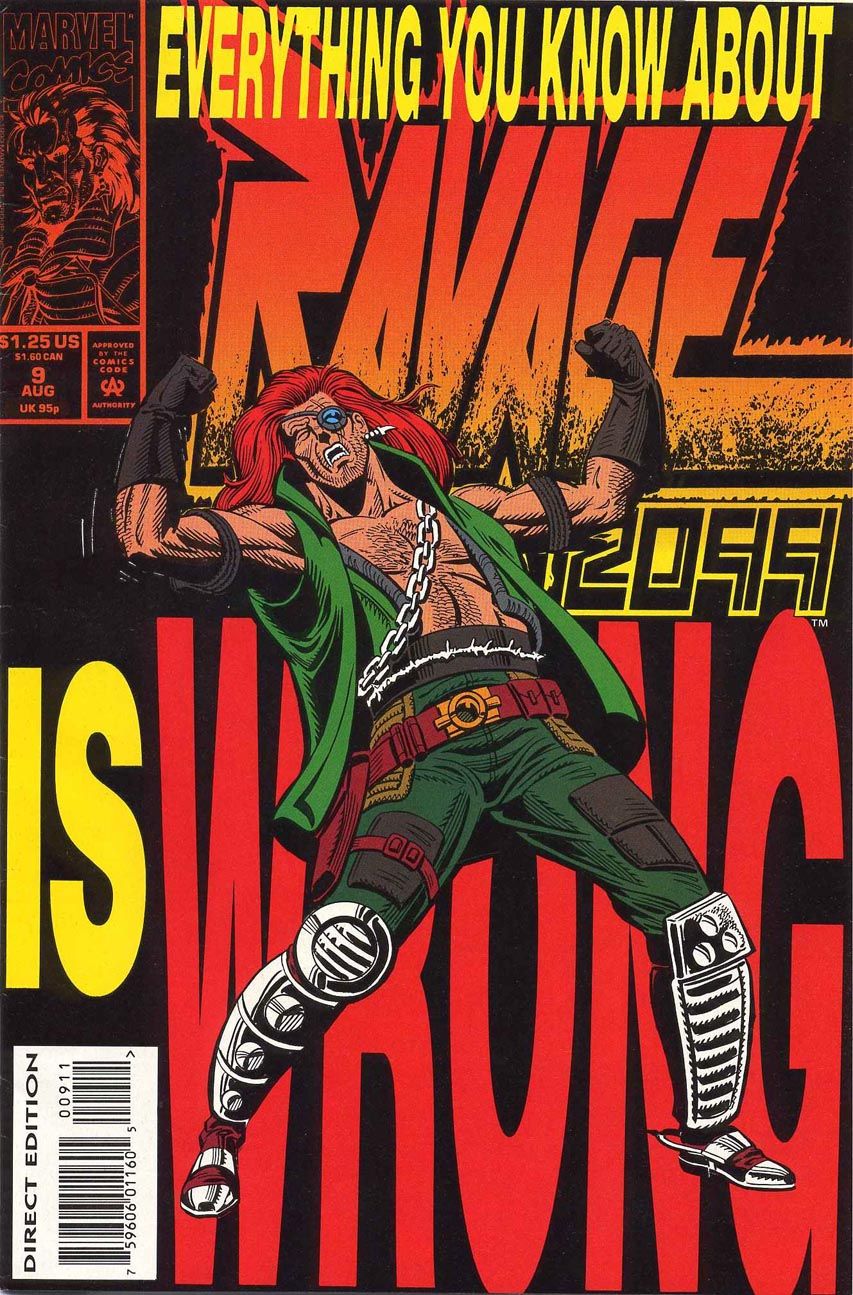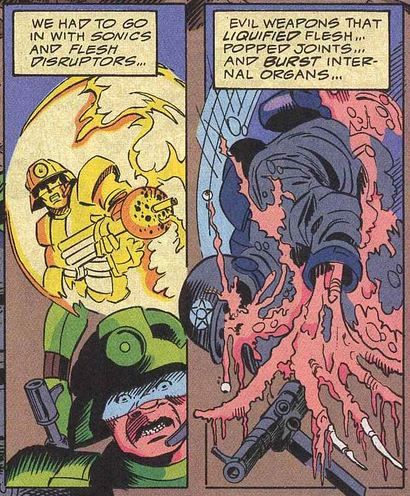Welcome to the first installment of Worth Something Someday, a series of (as Archduke Cronin would say) indefinite length and regularity, in which we critically re-examine and attempt to contextualize comic books of the 1990s. "The '90s" was the most infamous and tumultuous decade of comics since the 1950s, during which the industry experienced its highest highs as well as its most crashing lows. Some call it "The Dark Age," but now comes the time to shed some light on the era. Many of the comics we shall cover were purchased by speculators and secreted away with the hopes that they'd be worth something someday. So let's ask: are they worth it?
Where else to start our look at comics at the tail end of the 20th century, than with one that takes place at the tail end of the 21st, with a cover that declares everything we know... is wrong!?
Ravage 2099 #9 - Written by Pat Mills & Tony Skinner, Pencils by José Delbo, Inks by Keith Williams, Letters by Phil Felix, Colors by Gina Going, Edits by Joey Cavalieri. Published by Marvel Comics.
The cover date is August, 1993, which means this likely came out in June. What happened in the world while this was on the stands? Canada elected its first female prime minister; the Unabomber struck again; Bill Clinton announced "Don't Ask, Don't Tell"; earthquakes and tsunamis struck Japan; Jurassic Park premiered; Magic: The Gathering debuted; NASA lost the Mars Observer; Alec Baldwin and Kim Basinger got married; GG Allin died of a drug overdose; Lorena Bobbit cut off her husband's member and threw it into a field.
Stan Lee defined Marvel Comics as a brand. From steering the ship in the earliest days of the Marvel Universe to spewing moxie all over the pages of Bullpen Bulletins, Lee set a precedent for the comportment of the comic book industry, not just in terms of content and characterization but in personality. Marvel characters rely on internal or interpersonal conflict, but Marvel as a media machine presents the opposite to the world, basing its public identity on the infinite exuberance and charming arrogance of Lee's copy from the '60s, where fans were "True Believers" and every sentence ended in at least one exclamation point. After all, he rather bombastically proclaimed The Fantastic Four to be the "Great Comic Magazine in the World!!" on the cover of its third issue. Marvel Comics were the coolest-- why wouldn't you buy one?
That same issue of Fantastic Four describes the book as a "collectors'-item", which would become a prophetic statement. By the 1990s, the general public had discovered there was gold in them there pages, and comic books began selling higher numbers on the collectors' market. Suddenly, the worthless paper in your grandfather's basement or attic paid for your kids to go to college-- or would, in the future. Speculators snapped up copies in the millions and the comics industry catered directly to them with new #1 issues and variant foil fool's gold covers. It was here when Stan Lee, president emeritus of Marvel, whose name proudly presented each issue of every series, made his triumphant return to comics in the '90s Speculation Age, with the next great original Marvel hero. What did we know about Ravage that was so wrong?
Marvel launched a line of comics taking place in the year 2099, filled with future versions of their characters, in a society ruled by corporations, where littering is a capital offense, pollution turns men into mutroids, everyone wears business overalls, and pogs are still hip. Stan Lee and Paul Ryan (not that one, the other one) produced the only series not based around a pre-existing character. Paul-Phillip Ravage, a top executive at Eco, an environmental agency/police force, is betrayed by top brass and set up to die. He quickly turns badass, starts talkin' like Ben Grimm, outfits himself with weapons and armor at a junkyard, and starts fightin' The Man. Later, radiation from Hellrock, an island of Mutroids ruled by-- wait for it-- Dethstryk, gives him the ability to shoot energy from his hands.
The opening issues progressed almost improvisationally, with tweaks and retooling coming with each passing issue. Ravage initially digs his gear out a junkyard, then he gets a laser-proof coat lining (really), then he shoots giant energy beams from his hands, then he gets a high-tech eyepatch-monocle. This progression of change and revamping reminds one of the various kicks in the pants that Hank Pym and the Hulk underwent in the '60s to become more sellable, or the slow early evolution of the Fantastic Four concept. Seven and a half issues later (Lee "plotted" #8), however, Stan and Paul were gone, replaced by Mills, Skinner, and artist Grant Miehm. The series underwent a far more massive retooling, completely changing its main character.
Ravage, his gal Friday Tiana, and his Shortround sidekick Dack have stolen a disc with 1500 megabytes (that's a lot!) of incriminating info on their enemies, but crashland their stolen Fantasti-car in a barrio. We know it's a barrio because we're introduced to Barrio Man, the informal superheroic mayor of the town, with his Codex Heroica. Ravage, horns growing from his face, has started undergoing another transformation, his "biological software" doing a system restore, "default[ing] into primary mode," an evolutionary throwback of man. We get a new dump of information-- how Ravage led the Green Berets (get it?) in the Pollution Wars, which was in actuality a corporations vs. government conflict in which the company men won. In quick succession, first Dack quits the sidekick biz and then Tiana kicks Ravage to the curb. A wedding takes place in the barrio-- one where the formal wear consists of superhero costumes-- and Ravage stumbles upon some more thuggish corporate troopers. Cue shadowy cliffhanger splash page, teasing the reveal from the next issue which would put Ravage into full-on beast-man mode.
The main character's demeanor, appearance, superpowers, setting, supporting cast, all changed in the coming issues. Ravage would drop the stubble, the blue collar accent, the guns, the chains, all the standard "extreme" accoutrement, turning into a claw-and-muscles type of character. Mills and Skinner tease some future story threads in #9 as we get a peak in on Ravage's never-before-seen family, long enough to witness the murder of Ravage's brother. The series quickly shoved the previous status quo aside and this particular issue served as a backdoor pilot for itself, transitioning from Stan Lee's Marvel Age sensibility to Mills and Skinner's 2000 AD (more like 2099 AD, amirite?) approach.
The "everything you knew about ___ was wrong!" gimmick seemed prevalent in '90s comics, as the super-dense weight of continuity collapsed into a black hole, and stories became about themselves, featuring dark secrets from the past looming once again. Was everything we knew about Ravage 2099 proven wrong? Not really-- but I can't imagine the editorial or structural mayhem which must have been occurring behind the scenes, or what may have led the gears to be switched so ferociously so early in the run. Still, as a kid I enjoyed the series on both halves of the divide, simply as the adventure comics they set out to be. As an adult, I find it great fun watching Stan Lee try to write a comic for the 1990s, just as I still dig Mills and Skinner's slightly more satirical and character-focused issues, along with that fine Grant Miehm art.
For a character created by the biggest name in comics, we've yet to see a revamp of Ravage 2099, despite Marvel digging through the vaults looking for more existing properties to polish up and throw back into the market. There is no Ravage 2013 on the horizon, as far as I can tell, no mini-series published solely for the purpose of trademark renewal. Whatever happened to Ravage 2099? According to Wikipedia, "Ravage (presumably) died after being immersed in liquid adamantium by Doom and sent into space," a fate fit for the Poochie of 2099, the forgotten future of Marvel comics.
Is this comic worth anything? Oh, but Ravage 2099 contains multitudes. As a quarter-bin castoff, it represents a failed original property in a failed line of comics that nonetheless contained some good stories and cool ideas-- Spider-Man 2099 is still a cult favorite, and a character who still shows up from time to time. As the only comic Stan Lee wrote in the '90s, it gives us an eyewitness account of the collision between the unstoppable force of Stan Lee and the immovable object of '90s excess. As a window into the future of the Marvel Universe? Assuming comics as we know them, let alone human beings, survive to the year 2099, I don't expect these prophesies to come true. (Well, we will be ruled by corporations, but...) Spider-Man will still be Peter Parker, Punisher will still be Frank Castle, and Ravage? Ravage will still be the "hero that never existed."
Still, for a series which started out with a trenchcoated, kneepadded, scarred-eyed, gun-toting anti-hero fighting against the man which abruptly became a story about the man, who turned into a beast and clawed his way out from the inside, it wasn't half-bad. But then, it was the '90s. Everything we knew was wrong.
Sign of the times: This issue features an ad for The Meteor Man. Said character later featured in his own Marvel series. Maybe we'll talk about it someday.
Up next: Will there be a next time? You'd better leave suggestions for your favorite and least favorite '90s comics below.
Bill Reed will be at NYCC this weekend, and if you catch him he has to give you his pot of gold. Follow him on Twitter @billreads so he feels validated.



